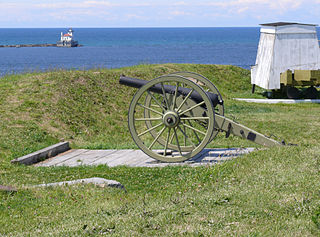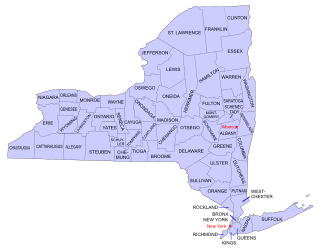
Fort Ontario is an American historic fort situated by the City of Oswego in Oswego County, New York. It is owned by the state of New York and operated as a museum known as Fort Ontario State Historic Site.

Buildings, sites, districts, and objects in New York listed on the National Register of Historic Places:

Oswego Armory is a historic National Guard armory located at Oswego in Oswego County, New York. It is a brick and stone castle-like structure built in 1906–1908. It was designed by State architect George L. Heins. It consists of a 2 1⁄2-story administration building with an attached large, gable-roofed drill shed. The building features a 5-story octagonal tower at the northwest corner.

Mount Adnah Cemetery is a historic rural cemetery located at Fulton in Oswego County, New York. It was designed in 1853 and within the boundaries of this contributing site are two contributing buildings, 10 contributing structures, and five contributing objects. Notable burials include M. Lindley Lee (1805-1876).

Volkert Van Buren House is a historic home located near Fulton in Oswego County, New York. It is a Federal style structure constructed about 1832.

The Orson Ames House is a historic house located at 3339 Main Street in Mexico, Oswego County, New York.

Nathan and Clarissa Green House is a historic home located at Oswego in Oswego County, New York. It is a two-story wood-frame residence with a gabled, three-bay facade and side entrance, built about 1849 with Greek Revival details. It was built by Nathan Green, an African American and fugitive slave, who purchased the lot from Gerrit Smith. It is located next to the John and Harriet McKenzie House.

Edwin W. and Charlotte Clarke House is a historic home located at Oswego in Oswego County, New York. It is a 2 1⁄2-story brick Italianate style residence built in 1857. Edwin W. and Charlotte Clarke were prominent abolitionists and it is believed that the house was a way station on the Underground Railroad.

Daniel and Miriam Pease House is a historic home located at Oswego in Oswego County, New York. It is a five bay, two story frame Federal style residence with a one-story rear wing. Also on the property is a three-story timber framed barn. Its owners, Daniel and Miriam Pease, were noted abolitionists and the house is documented as having been used as a way station on the Underground Railroad.

Richardson-Bates House is a historic home located at Oswego in Oswego County, New York. It is constructed primarily of brick and built in two stages. The main section is a 2 1⁄2-story, Tuscan Villa style brick residence with a gable roof and 4-story tower designed by architect Andrew Jackson Warner about 1867. The interior features carved woodwork by Louis Lavonier. The South wing addition included a private library, formal dining room and kitchen that was completed in 1889.

Kingsford House is a historic home located at Oswego in Oswego County, New York. It is a large 2 1⁄2-story brick residence. Built about 1870 in the Italianate style, it was extensively reconfigured and enlarged in 1912–1913 in the Tudor Revival style. Along the north and east edge of the property is a terrace wall built of cut limestone blocks and topped by a cast and wrought iron fence.

John B. and Lydia Edwards House is a historic home located at Oswego in Oswego County, New York. It is a two-story, rectangular frame residence built between 1834 and 1835. Its owner John B. Edwards was abolitionist Gerrit Smith's agent at Oswego and the house is well documented as a way station on the Underground Railroad.

John and Harriet McKenzie House is a historic home located at Oswego in Oswego County, New York. It is a 1 1⁄2-story, rectangular frame residence with Greek Revival details. Its owner John McKenzie was a former fugitive slave who built the house about 1847. Two years later Nathan and Clarissa Green built their house next door.

George B. Sloan Estate is a historic home located at Oswego in Oswego County, New York. It is a 2 1⁄2-story, irregularly massed, Ithaca limestone building built between 1866 and 1870 in the Italian Villa style. It features a square, 3-story engaged tower. Also on the property is a carriage house, cast-iron fence, and fountain.

Market House, also known as The Market Hall and The D.L.& W. Hall, is a historic market building located at Oswego in Oswego County, New York. It was built in 1835 and is a massive brick and stone structure overlooking the Oswego River. The structure originally housed several government entities including city hall. A new city hall was constructed in 1870 and completed in 1872. A section of the basement is believed to have been used as a jail. In 1864 the city sold it to the Oswego and Syracuse Railroad, that used it for the next 80 years as office and storage space. The railroad upgraded the building with a bracketed cornice and elaborate cupola.

The Northrup-Gilbert House is a historic home located at Phoenix in Oswego County, New York. It is a 1 1⁄2-story frame residence that appears to have been built in the 1840s. It has Greek Revival–style details.

Hamilton Farmstead is a historic farm complex and national historic district located at Mexico in Oswego County, New York. The district includes three contributing structures; the farmhouse, a barn, and a milkhouse; and three hand-dug wells. The farmhouse is a three bay, two story cobblestone building built in 1848 in the Greek Revival style.

Oswego Meeting House and Friends' Cemetery is a historic Society of Friends meeting house and cemetery in Moore's Mill, Dutchess County, New York. It was built in 1790 and is a 1 1⁄2-story frame building sided with clapboards and wooden shingles. It has a moderately pitched gable roof and two entrances on the front facade, each flanked by two windows. The cemetery contains about 50 stones and burials range in date from the 1790s to 1880s. Also on the property is a privy.

Tanner Block is a historic commercial building located at Oswego in Oswego County, New York. It was built in 1890 and is a four-story brick structure constructed in an eclectic Victorian style. It measures 44 feet wide and 100 feet deep. It originally housed a hardware store. It was updated in 1926 to house a furniture store and again updated in the 1960s.

Washington Square Historic District is a national historic district located at Oswego in Oswego County, New York. It includes 39 contributing buildings, one contributing structure, and one contributing site. It encompasses the historic civic and religious center on the east side of the city. There are 37 residences, four churches, a synagogue, a public green, the county office building and County Courthouse, and a former railroad tunnel. Located within the district are the separately listed Hamilton and Rhoda Littlefield House, Richardson-Bates House, Oswego City Library and Oswego County Courthouse. Washington Park was laid out in 1797 when the city of Oswego was laid out.














